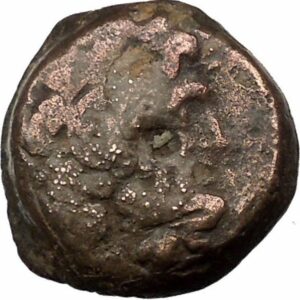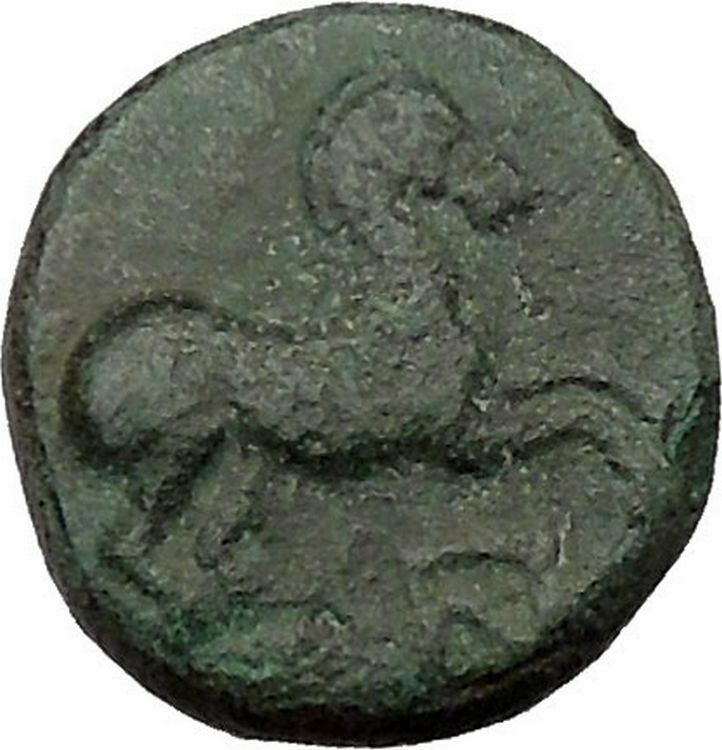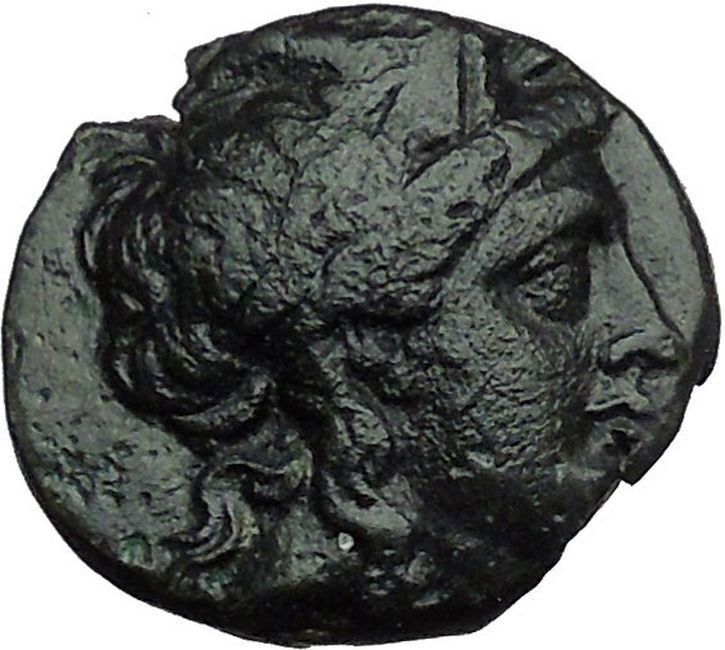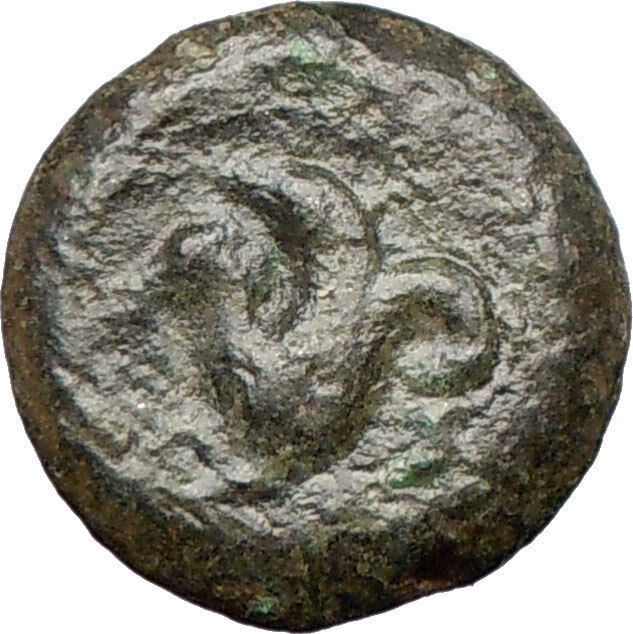|
Greek city of Berytos in Phoenicia
Bronze 10mm (0.40 grams) Struck circa 218-222 A.D.
Reference: SNGCop 89; BMC 27-35
. C-L to left and right of Marsyas standing left, holding wine-skin /
BER, Prow right.
You are bidding on the exact item pictured,
provided with a Certificate of Authenticity and Lifetime Guarantee of
Authenticity.
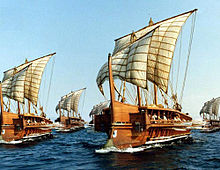
A
galley is a type of
ship propelled by
rowers
that originated in the eastern
Mediterranean Sea
and was used for
warfare
,
trade
and
piracy
from the first millennium BC. Galleys
dominated
naval warfare
in the Mediterranean from the 8th
century BC until development of advanced sailing warships in the 17th century.
Galleys fought in the wars of
Assyria
, ancient
Phoenicia
,
Greece
,
Carthage
and
Rome
until the 4th century AD. After the fall
of the
Western Roman Empire
galleys formed the
mainstay of the
Byzantine navy
and other navies of successors
of the Roman Empire, as well as new
Muslim
navies. Medieval Mediterranean states,
notably the Italian maritime republics, including
Venice
,
Pisa
,
Genoa
and the
Ottoman Empire
relied on them as the primary
warships of their fleets until the 17th century, when they were gradually
replaced by sailing warships. Galleys continued to be applied in minor roles in
the Mediterranean and the
Baltic Sea
even after the introduction of
steam propelled
ships in the early 19th
century.
The galley engagements at
Actium
and
Lepanto
are among the greatest
naval battles
in history.
In
Greek mythology
, a satyr is one of a
troop of male companions of
Pan
and
Dionysus
with
goat-like (caprine) features, including a goat-tail, goat-like ears,
and sometimes a goat-like phallus. In Roman Mythology there is a similar concept
with goat-like features, the
faun being half-man, half-goat. Greek-speaking Romans often use the
Greek term saturos when referring to the Latin faunus, and
eventually syncretize the two. The female “Satyresses”
were a late invention of poets — that roamed the woods and mountains. In myths
they are often associated with pipe-playing.

The satyrs’ chief was
Silenus
, a minor deity associated (like
Hermes
and
Priapus
) with fertility. These characters can
be found in the only complete remaining
satyr play
, Cyclops, by
Euripides
, and the fragments of
Sophocles
‘
Ichneutae
(Tracking Satyrs). The
satyr play was a short, lighthearted tailpiece performed after each trilogy of
tragedies in Athenian
festivals honoring Dionysus
. There is not
enough evidence to determine whether the satyr play regularly drew on the same
myths as those dramatized in the tragedies that preceded. The groundbreaking
tragic playwright
Aeschylus
is said to have been especially loved
for his satyr plays, but none of them have survived.
Attic painted vases
depict mature satyrs as
being strongly built with flat noses, large pointed ears, long curly hair, and
full beards
, with
wreaths
of vine or ivy circling their balding
heads. Satyrs often carry the
thyrsus
: the rod of
Dionysus
tipped with a pine cone.
Satyrs acquired their
goat-like aspect through later Roman conflation with
Faunus
, a carefree
Italic
nature spirit of similar characteristics
and identified with the Greek god
Pan
. Hence satyrs are most commonly described
in Latin literature as having the upper half of a man and the lower half of a
goat, with a goat’s tail in place of the Greek tradition of horse-tailed satyrs;
therefore, satyrs became nearly identical with
fauns. Mature satyrs are often depicted in Roman art with goat’s
horns
, while juveniles are often shown with
bony nubs on their foreheads.
About Satyrs, Praxiteles gives a new interpretation on the subject of free
and carefree life. Instead of an elf with pointed ears and repulsive goat
hooves, we face a child of nature, pure, but tame and fearless and brutal
instincts necessary to enable it to defend itself against threats, and survives
even without the help of modern civilization . Above all though, the Satyr with
flute has a small companion for him, shows the deep connection with nature, the
soft whistle of the wind, the sound of gurgling water of the crystal spring, the
birds singing, or perhaps the singing a melody of a human soul that feeds higher
feelings. As Dionysiac creatures they are lovers of wine and women, and they are
ready for every physical pleasure. They roam to the music of pipes (auloi),
cymbals
,
castanets
, and
bagpipes
, and they love to dance with the
nymphs
(with whom they are obsessed, and whom
they often pursue), and have a special form of dance called
sikinnis
. Because of their love of wine, they
are often represented holding wine cups, and they appear often in the
decorations on wine cups.
In Greek mythology
and art

This
Hellenistic
satyr wears a rustic
perizoma (loincloth)
and carries a pedum (shepherd’s crook).
Walters Art Museum
,
Baltimore
.

Satyr on a mountain goat, drinking with women, in a
Gandhara relief
of 2nd-4th century
CE

Dancing satyr on a
sardonyx
intaglio
holding a
thyrsus
in his left hand and a
kantharos
in the right hand. On the
right arm, the skin of a panther (pardalis). 1st century BC or
beginning of 1st century.
In earlier Greek art, satyrs appear as old and ugly, but in later art,
especially in works of the
Attic school
, this savage characteristic is
softened into a more youthful and graceful aspect.
This transformation or humanization of the Satyr appears throughout late
Greek art. Another example of this shift occurs in the portrayal of
Medusa
and in that of the
Amazon
, characters who are traditionally
depicted as barbaric and uncivilized. A very humanized Satyr is depicted in a
work of Praxiteles
known as the “Resting
Satyr“.

Notice, the goat on the left has a short goat tail, but the Greek
satyr on the right has a long horse tail. Not a goat tail (Attic
ceramic, 520 BCE).
Older satyrs were known as
sileni
, the younger as
satyrisci
. The
hare was the symbol of the shy and timid satyr. Greek spirits known
as
Calicantsars
have a noticeable resemblance to
the ancient satyrs; they have goats’ ears and the feet of
donkeys
or goats or horses, are covered with
hair, and love women and the dance.
Although they are not mentioned by
Homer
, in a fragment of
Hesiod
‘s works they are called brothers of the
mountain nymphs and
Kuretes
, strongly connected with the
cult of Dionysus
. In the Dionysus cult, male
followers are known as satyrs and female followers as
maenads
or bacchants.
In Attica there was a species of drama known as the legends of gods and
heroes, and the chorus was composed of satyrs and sileni. In the Athenian
satyr plays
of the 5th century BC, the chorus
commented on the action. This “satyric drama” burlesqued the serious events of
the mythic past with lewd
pantomime
and subversive mockery. One complete
satyr play from the 5th century survives, the
Cyclops
of
Euripides
.
The Satyr and the Traveller
, one of
Aesop’s Fables
, features the satyr as the
benevolent host for a traveller in the forest in winter. The satyr is bewildered
by the man’s claim to be able to blow hot and cold with the same breath, first
to warm his hands, then to cool his porridge, and turns him out for this
inconstancy.
A papyrus
bearing a long fragment of a satyr play
by Sophocles
, given the title ‘Tracking Satyrs’ (Ichneutae),
was found at
Oxyrhynchus
in
Egypt
, 1907.
In Roman mythology
and art

Satyr pursuing a
nymph
, on a Roman mosaic
Faunus were conflated in the popular and poetic imagination with Latin
spirits of woodland and with the rustic Greek god Pan. Roman satyrs were
described as goat-like from the
haunches
to the
hooves
, and were often pictured with larger
horns, even
ram
‘s horns. Roman poets often conflated them
with the fauns
.
Roman satire
is a
literary
form, a
poetic essay
that was a vehicle for biting,
subversive social and personal criticism. Though Roman satire is sometimes
linked to the Greek satyr plays, satire’s only connection to the satyric drama
is through the subversive nature of the satyrs themselves, as forces in
opposition to urbanity,
decorum
, and civilization itself.
Other references

Nymphs and Satyr
(William-Adolphe
Bouguereau, 1873)
In many versions of the
Bible
, Isaiah 13:21 and 34:14, the English word
“satyr” is used to represent the
Hebrew
se’irim, “hairy ones,” from
“sa’ir” or “goat”. There is an allusion to the practice of sacrificing to the
se’irim (KJV “devils”; ASV “he-goats”) in Leviticus 17:7. They may correspond to
the “shaggy demon of the mountain-pass” (azabb al-‘akaba) of old
Arab
legend. It may otherwise refer to literal
goats, and the worship of such.
The savant
Sir William Jones
often refers to the Indian
mythological
Vānaras
as satyrs/mountaineers in his
translations of Sanskrit
works.[citation
needed] This view is generally held to be a mistake
by present day researchers.[citation
needed]
Baby satyr

Female Satyr Carrying Two Putti by
Claude Michel
(1738–1814)

Bronze satyr (height 0.35m) from the
Mahdia shipwreck
(Musée
National du Bardo, Tunis.)
Baby satyrs, or child satyrs, are
mythological creatures
related to the satyr.
They appear in popular
folklore
,
classical
artworks,
film, and in various forms of local art.
Some classical works depict young satyrs being tended to by older, sober
satyrs, while there are also some representations of child satyrs taking part in
Bacchanalian
/
Dionysian rituals
(including drinking
alcohol
, playing
musical instruments
, and
dancing
).
The presence of a baby or child satyr in a classical work, such as on a
Greek vase
, was mainly an aesthetic choice on
the part of the artist. However, the role of a child in Greek art might imply a
further meaning for baby satyrs:
Eros
, the son of
Aphrodite
, is consistently represented as a
child or baby, and Bacchus, the divine sponsor of satyrs, is seen in numerous
works as a baby, often in the company of the satyrs. A prominent instance of a
baby satyr outside
ancient Greece
is
Albrecht Dürer
‘s 1505 engraving, “Musical Satyr
and Nymph with Baby (Satyr’s Family)”. There is also a
Victorian period
napkin ring depicting a baby
satyr next to a barrel, which further represents the perception of baby satyrs
as partaking in the Bacchanalian festivities.
There are also many works of art of the
rococo
period depicting child or baby satyrs in
Bacchanalian celebrations. Some works depict female satyrs with their children;
others describe the child satyrs as playing an active role in the events,
including one instance of a painting by
Jean Raoux
(1677–1735). “Mlle Prévost as a
Bacchante” depicts a child satyr playing a tambourine while Mlle Prévost, a
dancer at the Opéra, is dancing as part of the Bacchanal festivities.
Satyrs and orangutan
In the 17th century, the satyr legend came to be associated with stories of
the orangutan
, a great ape now found only in
Sumatra
and
Borneo
. Many early accounts which apparently
refer to this animal describe the males as being sexually aggressive towards
human women and towards females of its own species. The first scientific name
given to this ape was
Simia satyrus
.
Varieties
- Island Satyrs, which according to
Pausanias
were a savage race of red-haired,
satyr-like creatures from an isolated island chain.
- Libyan Aegipanes (goat-pans), which according to
Pliny the Elder
lived in
Libya
, had human heads and torsos, and the
legs and horns of goats, and were similar to the Greek god
Pan
.
- Libyan Satyr, which according to
Pliny the Elder
lived in
Libya
and resembled humans with long,
pointed ears and horse tails, similar to the Greek nature-spirit satyrs.
Medieval bestiaries
also mention several
varieties of satyrs, sometimes comparing them to apes or monkeys.

A bald, bearded, horse-tailed satyr balances a winecup on his penis,
on an Attic red-figured
psykter
, ca. 500-490 BC
- Centaur
, half man, half horse (Greek
mythology)
- Faun
, (Roman
mythology)
- Fairy
- Glaistig
, (Scottish
folklore)
- Jinn
-
Leszi
, (Slavic
mythology)
-
List of satyrs in popular culture
-
Pan
, (Greek mythology)
-
Sileni
, (Greek mythology)
The Birth of Tragedy
, by
Nietzsche
-
Thiasos
, the
Dionysian
retinue
- Torgo, a character in
Manos: The Hands of Fate
-
Urisk
, goat-man fairy (Scottish folklore)
The Trackers of Oxyrhynchus
, a play

Medieval depiction of a Satyr (Satyrs) from the
Aberdeen Bestiary
.
In
Greek mythology
, the
satyr
Marsyas (Ancient Greek:
Μαρσύας) is a central figure in two
stories involving death: in one, he picked up the double flute (aulos)
that had been abandoned by
Athena
and played it; in the other, he
challenged Apollo
to a contest of music and lost his hide
and life. In
Antiquity
, literary sources often emphasise the
hubris
of Marsyas and the justice of his
punishment.

Marsyas under Apollo’s punishment;
İstanbul Archaeology Museum
.
In one conjunction
Rhea
/Cybele,
and his episodes are situated by the mythographers in
Celaenae
(or Kelainai) in
Phrygia
(today, the town of
Dinar
in
Turkey
), at the main source of the
Meander
(the river
Menderes
).
When a genealogy was applied to him, Marsyas was the son of
Olympus
(son of
Heracles
and
Euboea
, daughter of
Thespius
), or of
Oeagrus
, or of Hyagnis. Olympus was,
alternatively, said to be Marsyas’ son or pupil.
The finding of the
aulos
Marsyas was an expert player on the double-piped
reed instrument
known as the
aulos
. In the anecdotal account, he found the
instrument on the ground where it had been tossed aside with a curse by its
inventor, Athena
, after the other gods made sport of how
her cheeks bulged when she played. The 5th-century poet Telestes doubted that
virginal Athena could have been motivated by such vanity, but in the 2nd century
AD, on the
Acropolis of Athens
itself, the voyager
Pausanias
saw “a statue of Athena striking
Marsyas the Silenos for taking up the flutes that the goddess wished to be cast
away for good.”
Marsyas and Apollo

In the contest between Apollo and Marsyas, the terms stated that the winner
could treat the defeated party any way he wanted. Since the contest was judged
by the
Muses
, Marsyas naturally lost and was
flayed
alive in a cave near Celaenae for his
hubris
to challenge a god. Apollo then nailed
Marsyas’ skin to a pine tree, near
Lake Aulocrene
(the Turkish Karakuyu Gölü),
which Strabo
noted was full of the
reeds
from which the pipes were fashioned.
Diodorus Siculus
felt that Apollo must have
repented this “excessive” deed, and said that he had laid aside his lyre for a
while, but
Karl Kerenyi
observes of the flaying of Marsyas’
“shaggy hide: a penalty which will not seem especially cruel if one assumes that
Marsyas’ animal guise was merely a masquerade.” Classical Greeks were unaware of
such
shamanistic
overtones, and the Flaying of
Marsyas became a theme for painting and sculpture. His brothers, nymphs, gods
and goddesses mourned his death, and their tears, according to
Ovid‘s
Metamorphoses
, were the source of the river
Marsyas
in
Phrygia
, which joins the
Meander
near Celaenae, where Herodotus reported
that the flayed skin of Marsyas was still to be seen, and
Ptolemy Hephaestion
recorded a “festival of
Apollo, where the skins of all those victims one has flayed are offered to the
god.” Plato
was of the opinion that it had been made
into a wineskin
.
There are alternative sources of this story which state that it wasn’t
actually Marsyas who challenged Apollo but Apollo who challenged Marsyas because
of his jealousy of the satyr’s ability to play the flute. Therefore, hubris
would not necessarily be a theme in this tale; rather the capricious weakness of
the Gods and their equally weak nature in comparison to humans.
There are several versions of the contest; according to Hyginus, Marsyas was
departing as victor after the first round, when Apollo, turning his lyre upside
down, played the same tune. This was something that Marsyas could not do with
his flute. According to another version Marsyas was defeated when Apollo added
his voice to the sound of the lyre. Marsyas protested, arguing that the skill
with the instrument was to be compared, not the voice. However, Apollo replied
that when Marsyas blew into the pipes, he was doing almost the same thing
himself. The Muses supported Apollo’s claim, leading to his victory.
Ovid
touches upon the theme of Marsyas twice,
very briefly telling the tale in
Metamorphoses
vi.383-400, where he
concentrates on the tears shed into the river Marsyas, and making an
allusion
in
Fasti
, vi.649-710, where Ovid’s primary
focus is on the aulos and the roles of flute-players rather than Marsyas,
whose name is not actually mentioned.

The wise Marsyas
The hubristic Marsyas in surviving literary sources eclipses the figure of
the wise Marsyas suggested in a few words by the
Hellenistic
historian
Diodorus Siculus
, who refers to Marsyas as
admired for his intelligence (sunesis) and self-control (sophrosune),
not qualities found by Greeks in ordinary satyrs. In
Plato
‘s Symposium, when
Alcibiades
likens Socrates to Marsyas, it is
this aspect of the wise satyr that is intended. Jocelyn Small identifies in
Marsyas an artist great enough to challenge a god, who can only be defeated
through a ruse. A prominent statue of Marsyas as a wise old
silenus
stood near the
Roman Forum
.
This is the Marsyas of the journal Marsyas: Studies in the History of Art,
published since 1941 by students of the Institute of Art,
New York University
.
Prophecy and
free speech at Rome
Among the Romans, Marsyas was cast as the inventor of
augury
and a proponent of free speech (the
philosophical concept παρρησία, “parrhesia“)
and “speaking truth to power.” The earliest known representation of Marsyas at
Rome stood for at least 300 years in the
Roman Forum
near or in the
comitium
, the space for political activity. He
was depicted as a
silen
, carrying a
wineskin
on his left shoulder and raising his
right arm. The statue was regarded as an indicium libertatis, a symbol of
liberty, and was associated with demonstrations of the
plebs
, or common people. It often served as
a sort of kiosk
upon which invective verse was posted.
Marsyas served as a minister for Dionysus or Bacchus, who was
identified by the Romans with
their
Father Liber
, one of three deities in the
Aventine Triad
, along with
Ceres
and Libera (identified with
Persephone
). These gods were regarded as
concerning themselves specially with the welfare of the plebs. The
freedom that the
ecstasies
of
Dionysian worship
represented took on a
political meaning in Rome as the
libertas
that distinguished the free from
the enslaved. The
Liberalia
, celebrated March 17 in honor of
Liber, was a time of speaking freely, as the poet and playwright
Gnaeus Naevius
declared: “At the Liberalia
games we enjoy free speech.” Naevius, however, was arrested for his
invectives
against the powerful.
Marsyas was sometimes considered a king and contemporary of
Faunus
, portrayed by
Vergil
as a native Italian ruler at the time of
Aeneas
.
Servius
, in his
commentary
on the
Aeneid
, says that Marsyas sent Faunus
envoys who showed techniques of augury to the Italians. The plebeian
gens of the
Marcii
claimed that they were descended from
Marsyas.
Gaius Marcius Rutilus
, who rose to power from
the plebs
, is credited with having dedicated
the statue that stood in the Roman forum, most likely in 294 BC, when he became
the first plebeian
censor
and added the
cognomen
Censorinus to the family name
. Marcius Rutilus
was also among the first plebeian augurs,
co-opted
into their
college
in 300, and so the mythical teacher of
augury was an apt figure to represent him.[28]

The Torment of Marsyas (Le Supplice de Marsyas),
Louvre Museum
,
Paris
.
In 213 BC, two years after suffering one of the worst military defeats in its
history at the
Battle of Cannae
, Rome was in the grip of a
reactionary fear that led to excessive
religiosity
. The
senate
, alarmed that its authority was being
undermined by “prophets and sacrificers” in the forum, began a program of
suppression. Among the literature confiscated was an “authentic” prophecy
calling for the institution of
games in the Greek manner for Apollo
, which the
senate
and
elected officials
would control. The prophecy
was attributed to Gnaeus Marcius, reputed to be a descendant of Marsyas. The
games were duly carried out, but the Romans failed to bring the continuing
wars with the Carthaginians
to a victorious
conclusion until they heeded a second prophecy and imported the worship of the
Phrygian Great Mother
, whose song Marsyas was said to
have composed; the song had further relevance in that it was also credited by
the Phrygians with protecting them from invaders. The power relations between
Marsyas and Apollo reflected the continuing
Struggle of the Orders
between the elite and
the common people, expressed in political terms by
optimates
and
populares
. The arrest of Naevius for
exercising free speech also took place during this period.
Another descendant of Marcius Rutilus,
L. Marcius Censorinus
, issued coins depicting
the statue of Marsyas, at a time when the
augural college
was the subject of political
controversy during the
Sullan civil wars of the 80s BC
On the coin,
Marsyas wears a
Phrygian cap
or
pilleus
, an emblem of liberty. This Marcius
Censorinus was killed by
Sulla
and his head displayed outside
Praeneste
. Sulla’s legislative program
attempted to curtail power invested in the people, particularly restricting the
powers of the plebeian tribunes
, and to restore the dominance
of the senate and the privileges of
patricians
.
Marsyas was also claimed as the
eponym
of the
Marsi
, one of the ancient peoples of Italy.[34]
The
Social War of 91–88 BC
, in which the
Italian peoples
fought to advance their status
as citizens under Roman rule, is sometimes called the Marsic War from the
leadership of the Marsi. The Roman
coloniae
Paestum
and
Alba Fucens
, along with other Italian cities,
set up their own statues of Marsyas as assertions of their political status.
During the
Principate
, Marsyas became a subversive symbol
in opposition to
Augustus
, whose propaganda systematically
associated him with the silens’ torturer Apollo. Augustus’s daughter
Julia
held nocturnal assemblies at the statue,
and crowned it to defy her father. The poet
Ovid, who was ultimately exiled by Augustus, twice tells the story of
Marsyas’s flaying by Apollo, in his epic
Metamorphoses
and in the
Fasti
, the calendrical poem left unfinished
at his death. Although the immediate cause of Ovid’s exile remains one of
literary history’s great mysteries, Ovid himself says that a “poem and
transgression” were contributing factors; his poetry tests the boundaries of
permissible free speech during Rome’s transition from
republic
to
imperial monarchy
.
Pliny
indicates that in the 1st century AD, the
painting Marsyas religatus (“Marsyas Bound”), by
Zeuxis of Heraclea
, could be viewed at the
Temple of Concordia
in Rome.[39]
The goddess
Concordia
, like the Greek
Harmonia
, was a
personification
of both
musical harmony as it was understood in antiquity
,
and of social order
, as expressed by
Cicero
‘s phrase concordia ordinum. The
apparent incongruity of exhibiting the tortured silen in a temple devoted to
harmony has been interpreted in modern scholarship as a warning against
criticizing authority.
In later art

Athena and Marsyas: the discovery of the aulos in an
imaginative recreation of a lost bronze by
Myron
(Botanic Garden,
Copenhagen
)
In the art of later periods,
allegory
is applied to gloss the somewhat
ambivalent morality of the flaying of Marsyas. Marsyas is often seen with a
flute
,
pan pipes
or even
bagpipes
. Apollo is shown with his
lyre, or sometimes a
harp, viol
or other stringed instrument. The
contest of Apollo and Marsyas
is seen as
symbolizing the eternal struggle between the Apollonian and Dionysian aspects of
human nature.
Paintings taking Marsyas as a subject include “Apollo and Marsyas” by
Michelangelo Anselmi
(c. 1492 – c.1554), “The
Flaying of Marsyas” by
Jusepe de Ribera
(1591–1652),
“The Flaying of Marsyas”
by
Titian
(c. 1570-1576) and “Apollo and Marsyas”
by
Bartolomeo Manfredi
(St. Louis Art Museum).
James Merrill
based a poem, “Marsyas”, on this
myth; it appears in The Country of a Thousand Years of Peace (1959).
Zbigniew Herbert
and
Nadine Sabra Meyer
each titled poems “Apollo
and Marsyas”. Following Ovid’s retelling of the Apollo and Marsyas tale, the
poem “The Flaying Of Marsyas” features in Robin Robertson’s 1997 collection “a
painted field”.
In 2002, British artist
Anish Kapoor
created and installed an enormous
sculpture in London’s
Tate Modern
called “Marsyas”. The work,
consisting of three huge steel rings and a single red
PVC
membrane, was impossible to view as a whole
because of its size, but had obvious anatomical connotations.
There is a bridge built towards the end of the
Roman
period on the river Marsyas that is still
called by the satyr’s name, Marsiyas.
Berytos in Phoenicia
History
Beirut’s history goes back more than 5000 years.
Excavations in the
downtown
area have unearthed layers of Phoenician, Hellenistic, Roman, Arab
and Ottoman remains.
The first historical reference to Beirut dates from the 14th century BC, when it
is mentioned in the
cuneiform
tablets of the “Amarna
letters.” Ammunira
of Biruta[10]
(Beirut) sent three letters to the
pharaoh of Egypt
.
Biruta is also referenced in the letters from
Rib-Hadda
of Byblos
. The
most ancient settlement was on an island in the river that progressively silted
up. The city was known in antiquity as Berytus (Βηρυτός) (see also
List of traditional Greek place names
); this name was taken in 1934 for the
archaeological journal published by the Faculty of Arts and Sciences at the
American University of Beirut
.

Canaanean Blade
. Suggested to be
part of a
javelin
. Fresh grey
flint
, both sides showing
pressure flaking
. Somewhat narrower
at the base, suggesting a
haft
. Polished at the extreme
point. Found on land of the Lebanese Evangelical School for Girls in
the
Patriarchate
area of Beirut.
Hellenistic/Roman
period
In 140 BC, the city was destroyed by
Diodotus Tryphon
in his contest with
Antiochus VII Sidetes
for the throne of the
Seleucid
monarchy. Beirut was soon rebuilt on a more regularized
Hellenistic
plan, renamed Laodicea in Phoenicia (Greek:
Λαοδικεια ή του Φοινίκη) or Laodicea in
Canaan, in honor of a Seleucid
Laodice
. The modern city overlies the ancient one and little archaeology had
been accomplished until after the end of the civil war in 1991; now large sites
in the devastated city center have been opened to archaeological exploration. A
dig in 1994 established that one of Beirut’s modern streets, Souk Tawile, still
follows the lines of an ancient Hellenistic and Roman one.
Mid-first century coins of Berytus bear the head of
Tyche
, goddess of
fortune; on the reverse, the city’s symbol appears: a dolphin entwines an
anchor. This symbol was taken up by the early printer
Aldus Manutius
in 15th century
Venice
. Beirut
was conquered by Agrippa in 64 BC and the city was renamed in honor of the
emperor’s daughter, Julia; its full name became Colonia
Julia Augusta
Felix Berytus.
The veterans of two
Roman
legions
were established in the city: the fifth Macedonian and the third
Gallic. The city quickly became Romanized. Large public buildings and monuments
were erected and Berytus enjoyed full status as a part of the empire.
Under the Romans, it was enriched by the dynasty of
Herod the Great
, and was made a
colonia
, Colonia Iulia Augusta Felix Berytus, in 14 BC. Beirut’s
school of law was widely known at the time.
Two of Rome’s most famous jurists,
Papinian
and Ulpian
, both natives of Phoenicia, taught at the law school under the
Severan
emperors. When
Justinian
assembled his
Pandects
in the 6th century, a large part of the corpus of laws were
derived from these two jurists, and Justinian recognized the school as one of
the three official law schools of the empire (533). Within a few years, as the
result of a disastrous earthquake (551),
the students were transferred to
Sidon
.
About 30,000 were killed in Berytus alone and, along the Phoenician coast, total
casualties were close to 250,000.
|























